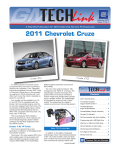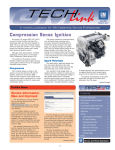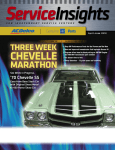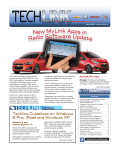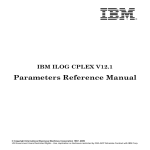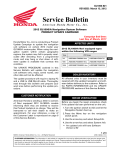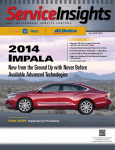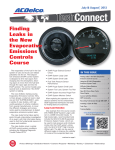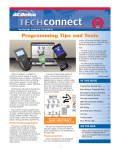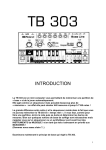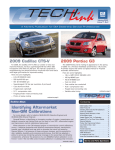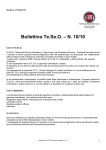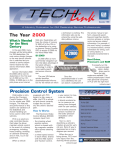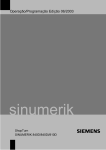Download 073 TechLink April 2010_April 2010 TechLink
Transcript
April 2010 Volume 12, No.4 Corroded or stripped electrical ground connections can cause a loss of module communication and other electrical system malfunctions, leading to unnecessary repairs and parts replacement. The electrical system relies on a secure, corrosion-free ground connection in order to function properly, so any damaged ground connections must be repaired to provide a good mounting point with a low resistance ground path and prevent future corrosion. GM recently released a new bulletin covering electrical ground connection repairs. Refer to bulletin #10-08-45-001 for complete repair and installation instructions. Here are the highlights. The bulletin outlines ground repair procedures using one of the following replacement fasteners with a conductive finish: • Welded M6 stud and nut • Welded M6 nut and bolt • Welded M8 nut and bolt Before installing a new fastener in the current ground location or at a new mounting location, remove any grease TIP: The surrounding area must be properly finished prior to the installation of the ground wire terminal and conductive nut to maintain a secure, stable and corrosion-free electrical ground. Thoroughly clean the stud threads using a residue-free solvent. Once dry, apply dielectric lubricant to the threads to reduce the possibility of fretting. TIP: Fretting corrosion is a build-up of insulating, oxidized wear debris than can continued on page 2 M6 conductive rivet stud from the repair area using a residue-free solvent. After drilling the mounting hole (for a new location), remove any paint and primer from the area until bare metal is visible. Install the appropriate new fastener and check that it is securely fastened without any detectable movement. Cover the stud threads with protective material and refinish the repair area using an anti-corrosion primer. SPO Changes Name to Customer Care and Aftersales GM recently announced that the Service Parts Operations (SPO) organization will now be known as GM Customer Care and Aftersales. It includes GM Service Operations, ACDelco, GM Goodwrench and GM Performance Parts. The name change was made to better reflect GM’s renewed emphasis on customer satisfaction and service after the sale. – Thanks to Lisa Scott April 2010 Contents Electrical Ground Repairs . . . . . . . . . . . . . SPO Changes Name to Customer Care and Aftersales . . . . . . . . . . . . . . . . . . . . . Installing Replacement Rear Leaf Spring . . . Various Electrical Conditions . . . . . . . . . . . Intermittent Service Park Assist Message . . Control Module Programming and Setup Procedures . . . . . . . . . . . . . . . Global A Architecture Programming Tip . . . 2010 Wheel Nut Torque Specifications . . . . Owner Manuals Available in SI . . . . . . . . . . New Battery Electrical Drain/Parasitic Load Test Diagnostic Procedure . . . . . . . . . . . . Subscribe or Unsubscribe to Paper Service Bulletins . . . . . . . . . . . . . . . 2010 Two-Mode Hybrid System Changes . . Power Steering Hose Retrofit Procedure . . . EBCM and BPMV Parts Restriction . . . . . . Properly Locking the Roof Rack Cross Rails . No Retained Accessory Power after Radio Replacement . . . . . . . . . . . . . . Inoperative Power Liftgate . . . . . . . . . . . . . Heated Seat and PPS Module Kit . . . . . . . . Car Issues – Fix It Right the First Time . . . . Truck Issues – Fix It Right the First Time . . . Service Know How . . . . . . . . . . . . . . . . . . .1 .1 .2 .2 .2 .3 .3 .4 .4 .5 .5 .5 .6 .6 .6 .7 .7 .7 .8 .8 .8 Customer Care and Aftersales 1 Electrical Ground Repairs Installing Replacement Rear Leaf Spring – continued from page 1 form when there is a small motion between electrical contacts, causing electrical resistance across the connection. Remove any corrosion or contamination on the electrical ground wire terminal. Install the terminal, tighten the conductive nut to the proper torque and verify system operation. Refer to the bulletin for a list of part numbers for the replacement fasteners and special tools. A video of the ground repair procedure can be viewed on the December 2009 edition of the Emerging Issues seminar (10209.12D). – Thanks to Dave Peacy When installing a replacement rear leaf spring on the 2004-2009 Colorado or Canyon, technicians may notice a change in the diameter of the center alignment bolt on the replacement spring. Inspect the replacement spring center alignment bolt. If the head of the bolt measures approximately 15mm, it is a new design spring. Installed M6 stud, washer and nut The rivet stud forms a collar on the rear side to prevent rotation in the hole. Various Electrical Conditions The following electrical issues may be evident on some 20052008 Cobalt, 2007-2008 G5 and 20052006 Pursuit (Canada only) models: SIR warning lamp illuminated, instrument A. Location of splice S361/J361 under the driver’s seat. panel lights flicker/inoperative, parking lamps flicker/inoperative, tail lamps dim/inoperative, trunk open lamp illuminated, radio inoperative, door lock inoperative, no start, or no crank. One possible cause of these conditions may be the interior wiring at the S361/J361 splice. Inspect splice S361/J361, parking lamp circuit, located in the body harness under the driver’s seat. Remove the driver's seat from the vehicle and the driver's door opening carpet retainer. Peel back the carpet to about the "B" pillar and inspect the wires. If there is any damage, repair splice S361/J361 and other wires. Be sure to shrink-wrap any repairs to protect against moisture. If there is excessive moisture or water evident, water-test the vehicle for any leaks. Rear leaf spring mounting plate Perform the following modification to allow installation of the replacement spring to the axle: 1. Obtain a 19/32" drill bit. TIP: Do not make a substitution for this drill bit size. Failure to use the specified size could alter the alignment of the vehicle and the driveline. 2. Carefully center the drill bit on the hole in the mounting plate on the axle and enlarge the hole. 3. Install the replacement spring, verifying proper fit to the axle. – Thanks to Jeremy Richardson Intermittent Service Park Assist Message An intermittent Service Park Assist Message may display on the DIC of some of the following models equipped with RPO UD7 or UD5: 2010 SRX, CTS Wagon, Escalade models, Avalanche, Camaro, Equinox, Silverado, Traverse, Tahoe, Suburban, Enclave, Acadia, Sierra, Terrain, and Yukon models. There may be one or more of the following DTCs stored in history: B0954 01, B0955 01, B0956 01, B0957 01, B0958 01, B0959 01, B0960 01, and/or B0961 01. If, after normal diagnostics, the cause of the condition is not found, reprogram the Park Assist Control Module with an updated calibration currently available in TIS2WEB. – Thanks to James Will – Thanks to Jim Loomis 2 April 2010 Control Module Programming and Setup Procedures Every time a control module is programmed or replaced, there are different setup procedures to follow to ensure that the control module and related components operate properly. All of these setup and initialization procedures, as well as critical information to ensure proper programming, are covered in the Control Module References table in the Service Information (SI). The table includes links to all information related to the programming of a control module, including: • Control module/scan tool information • Schematics • Repair instructions • Programming and setup information Check the Control Module References table in SI for control module programming and setup information. Setup Procedures Once programming is completed successfully, it’s critical to perform the necessary post-programming setup procedures. For example, when programming the Transfer Case Shift Control Module (TCCM), it’s necessary to perform the Transfer Case High/Low Clutch Reset procedure. From the Control Module References table, there is a link to the setup procedures and the Transfer Case High/Low Clutch Reset procedure, which lists the steps to perform the reset procedure using a scan tool or the transfer case shift control switch. From the Control Module Reference table, click the SPS link for complete programming information. TIP: If error codes appear during SPS programming, do NOT assume that the control module cannot be programmed. There are certain events that can interrupt programming. In most cases, a second attempt at programming will be successful. If an error code is received after the second attempt, document the code and contact TCSC for assistance. – Thanks to Mike Waszczenko and Dave Peacy Proper Programming To ensure proper programming, here are just a few of the items that should be checked before beginning the programming procedure: • Always verify a valid reason for reprogramming, such as if advised by the GM Technical Assistance Center (TAC) or GM Techline Customer Support Center (TCSC), or instructed by an SI document (recall, PI, service bulletin, etc.). Viewing existing calibrations in TIS2Web and deciding to reprogram because there are updates available is not a valid reason for reprogramming a module. • Nominal battery voltage should be 12.5 to 13.5 volts. This can be checked in most vehicles by connecting a scan tool and viewing the data display for the module. Look for the ‘battery voltage’ or ‘ignition 1’ signal to verify good voltage levels. • Due to the time requirements of programming a control module, connect a Midtronic charger (battery maintainer, PSC-550 or PSC-330) to maintain system voltage. If this tool is not available, do not connect a standard battery charger. Instead, connect a fully charged 12V jumper or booster pack disconnected from the AC power supply. • It is essential that the TIS2Web PC, MDI, and/or scan tool is equipped with the latest software. Please verify this before programming. • The ignition switch must be in the proper position. SPS prompts you to turn on the ignition, with the engine off. Do not change the position of the ignition switch during the programming procedure unless instructed to. Avoid programming interruptions of any kind, such as opening vehicle doors or depressing the brake pedal. It is also a good practice to make sure no other applications are active or running on the TIS2Web PC. • DTCs may set during programming. Clear DTCs after programming is complete. Global A Architecture Programming Tip After a control module has been replaced on a Global A vehicle (2010 Camaro, LaCrosse, SRX, Equinox and Terrain), in some instances, a security timer will be activated. When the security timer starts during the control module programming session, the Load ECU Status bar may briefly show activity before appearing to freeze up. The status message says "Connecting to the Server.” A security timer may cause programming to appear to freeze on this screen. Once the security timer counts down 10 minutes, the programming session will resume and complete normally. – Thanks to Paul Gallo and Jeff Flood April 2010 3 2010 Wheel Nut Torque Specifications 2010 Wheel Nut Torque Specifications Model Spec (N·m – lb.-ft.) Buick Enclave 190 – 140 LaCrosse 150 – 110 Lucerne 140 – 100 Cadillac CTS 190 – 140 DTS 140 – 100 Escalade, ESV, EXT 190 – 140 SRX 150 – 110 STS 140 – 100 Chevrolet Avalanche 190 – 140 Aveo 140 – 100 Camaro 190 – 140 Cobalt 140 – 100 Colorado 140 – 100 Corvette 140 – 100 Equinox 190 – 140 Express 190 – 140 HHR 140 – 100 Impala 140 – 100 Malibu 140 – 100 Silverado 190 – 140 Tahoe, Suburban 190 – 140 Traverse 190 – 140 GMC Acadia 190 – 140 Canyon 140 – 100 Savana 190 – 140 Sierra 190 – 140 Terrain 190 – 140 Yukon, Yukon XL 190 – 140 Wheel nut torque specifications over the years have often been consistent for all passenger cars or trucks as well as from one model year to the next. However, wheel sizes, assembly requirements and manufacturer designs have led to many changes and, as a result, torque specifications have changed too. Technicians should no longer assume the torque specification is the same as it always has been for a passenger car or truck. New specifications are put in place for a number of reasons and may change with each model year. Following are the 2010 model year wheel nut torque specifications. Use them any time a wheel is being installed on a vehicle. An improperly torqued wheel can cause brake rotor distortion, which leads to brake pedal pulsation. Refer to SI for additional information about proper wheel installation and tool use. It’s recommended to use a calibrated torque wrench to achieve the specified torque. The wheel nut torque specifications can be found in the Service and Appearance Care section of the owner manuals and the Suspension>Tires and Wheels section of the service manuals that are available on SI. – Thanks to Brad Thacher and Kathleen Jakes Owner Manuals Available in SI Looking for information on how to reset a vehicle’s power folding mirrors or program a replacement key fob? If the first place you would search for such information is the service manual available in the Service Information (SI), scroll down the page to another publication that is available in SI: the owner manual. SI includes all of a model’s owner manual publications, such as the owner manual, navigation system manual, or diesel engine supplement, in addition to the service manual/bulletins, accessories manual and labor time guide. The owner manual includes technical or service information that can be helpful in the service bay. TIP: Owner manual information is not repeated in the service manual information in SI. Here are two examples concerning the 2010 SRX of simple service/programming information found in the owner manual that is not available in the service manual. • If a Remote Keyless Entry (RKE) transmitter of an SRX with Keyless Access is lost and needs to be replaced, a new transmitter can be programmed at the dealership using SPS or by using the procedures outlined in the owner manual. Programming with or without a recognized transmitter is covered. Only the transmitters are needed using the owner manual procedure; no other tools are required. • If the power folding mirrors on an SRX vibrate at normal driving speeds or do not stay in the unfolded position, they may have been manually folded or 4 Check the vehicle owner manual in SI for additional information not found in the service manual. unfolded and need to be reset. Other conditions that require the mirrors to be reset and the reset procedure are listed in the owner manual, but are not in the service manual. – Thanks to Steve Apking and Jeremy Richardson April 2010 New Battery Electrical Drain/Parasitic Load Test Diagnostic Procedure The Battery Electrical Drain/Parasitic Load Test diagnostic procedure found in the Engine Electrical service category in GM Service Information has been updated starting with the 2010 model year. Changes were made to enhance the diagnostic procedure and offer additional information. More details provided by the field service engineers have been added to the Diagnostic Aids category to help technicians better understand how different components affect proper operation. For example, the diagnostic aids point out: • Aftermarket accessories installed into the courtesy lamp circuit can cause the inadvertent power timer in the BCM to keep resetting. This would cause the BCM to remain awake and cause a current drain on the battery. • An engine off natural vacuum evaporative test can occur if the ECM determines the drive cycle has met the appropriate criteria immediately after key off. The ECM will stay awake and the vent solenoid will stay energized for as long as 45 minutes. The typical current draw for this is about 1 A. • Some automatic climate control systems can remain in a semiawake state for up to three hours. Actual draw amounts vary by vehicle platform, but are typically not greater than 50 mA. The Circuit/System Verification category also has been updated to use either an inductive pickup probe or the essential tool J-38758 Parasitic Draw Test Switch. Now the technician can use either tool to perform the battery drain test. If an inductive pickup probe is available, it will greatly reduce the hook up and testing time. When using the J-38758 Parasitic Draw Test Switch, the new diagnostic procedure greatly reduces the number of steps required to determine if an excessive current draw is present or not. During testing the DMM mA current scale is no longer used, this eliminates the high risk of damaging the DMM milliamp fuse. – Thanks to Dave Nowak Subscribe or Unsubscribe to Paper Service Bulletins Dealerships can order as well as stop the delivery of paper service bulletins by completing the subscription options on GM GlobalConnect. Here are the instructions for “how to order” and “how to stop” paper copy service bulletins: 1. Log in to the GM GlobalConnect/Dealer World Portal 2. Click the DWD Store link 3. Click the Subscriptions link 4. You will see a list of options, with an associated box for each option 5. Two options are: 1. Field Product Bulletins, and 2. Technical Bulletins 6. If you want to subscribe, enter the desired quantity (number) in the boxes associated with Field and Product Bulletins and the boxes associated with Technical Bulletins. If you want to unsubscribe, enter a zero in these boxes. There are seven categories (Body Shop, Business Office, Finance Insurance, Parts, Sales, Service and Used) to enter a quantity number (to subscribe) or a zero (to unsubscribe) — see the accompanying subscription form. To subscribe or unsubscribe to paper bulletins, enter the desired quantity in the boxes associated with Field and Product Bulletins and Technical Bulletins 7. Click the Save button. TIP: It is very important to click the Save button in order to save your subscription changes. If you are having a problem subscribing or unsubscribing and would like help with the subscription process, call the GM Fulfillment Helpdesk at 1-866-700-0001. – Thanks to Vivian Williams, Chad O'Brien, Katul Patel, Michael Balon, Rick Gatt, and Tom Nguyen 2010 Two-Mode Hybrid System Changes large, such as backing up an incline, the engine will start and remain running until the transmission is shifted out of Reverse. If the incline is steep, the engine may increase in speed in a step function, causing a small bump. This is considered normal operation. • If conditions allow, the engine may now enter Auto Stop mode during a Remote Vehicle Start event. New connectors have been added on the transmission auxiliary fluid pump and auxiliary fluid pump control module. The connectors are incompatible with previous model years. Several changes in operating characteristics and hardware have been made to the Two-Mode Hybrid system (RPO HP2) available on the 2010 Escalade, Silverado, Tahoe, Sierra and Yukon. The ECM, HPCM, MCM1, MCM2, and TCM in 2010 models have completely new software. This software is incompatible with previous model years. The driving feel has some minor improvements, but behaves largely the same for the driver. Enhancements include: • The engine will enter Auto Stop mode while in Reverse. If the torque required to move the vehicle in Reverse is too April 2010 – Thanks to Charles Krepp 5 Power Steering Hose Retrofit Procedure EBCM and BPMV Parts Restriction The Electronic Brake Control Module (EBCM) Kit and the Brake Pressure Modulator Valve (BPMV) Kit for the 2010 LaCrosse, SRX, Camaro, Equinox and Terrain have been placed on parts restriction. These parts must be ordered through the GM TAC (Technical Assistance Center). Prior to contacting TAC, verify that proper diagnosis has been performed. • If DTCs are present and the Service Information (SI) procedure gives direction to replace the component, first capture snapshot stored data and, if possible, test drive the vehicle with the MDI and a laptop installed to capture a snap shot of the EBCM data when the condition occurs. Refer to the latest version of bulletin #10-07-30-002 for correct snapshot data collection. Save the snapshot as it may be requested for later use. New design hose assembly When servicing a 2006 Impala or Monte Carlo or a 2005-2006 Grand Prix, with a V8 engine, following bulletin #06-02-32-014, it’s important to note that the new power steering hose is physically different than the original. The newly designed hose has a fin-type cooler built onto the hose assembly. • If DTCs are not present, refer to Symptoms in SI and search all applicable bulletins/P.I.s for repair information prior to contacting TAC. The new design power steering hose should include installation instructions, which describe how to install the new design hose on vehicles that did not have this style hose previously. Per the installation instructions, it is necessary to drill mounting holes in the cradle to attach the new design hose assembly to the vehicle. • When calling TAC to review the case, have as much stored DTC and snapshot information as possible available. • After reviewing the diagnosis, if either component replacement is needed, TAC will arrange for ordering of the part(s). Record the TAC case number to be used by the parts department (in conjunction with the part #) as this is the control number needed to track shipment of the part. It is not necessary to call TAC for part tracking information. If the retrofit instructions have not been packed with the power steering hose kit or are not available to the technician working on the vehicle in the dealership, refer to PIC5318, which includes the complete removal and installation procedure. TIP: Always verify the correct part number listed in the Electronic Parts Catalog when ordering the power steering hose. – Thanks to Jeremy Richardson – Thanks to David Eplin Properly Locking the Roof Rack Cross Rail Some owners of the 2010 Equinox and Terrain may not be properly locking the roof rack cross rails in place. This information applies to both the factory installed and the GM Accessory roof rack cross rails. Do not replace any parts for this concern. The cross rails can be locked in four positions only. If the lever is not flat, the cross rail is not completely engaged. The lever should be flat and tight to the cross rail. The roof rack cross rails can be locked in four positions along the roof rack side rails. These four positions are the only positions where the cross rails will lock. Push the lever down to completely engage the cross rails into the side rail holes. Slide the cross rails back and forth until the lock pins engage in the holes. TIP: An audible click can be heard as the pins align and the cross rails lock. If the lever is not flat, the cross rail will not be completely engaged in a side rail hole. Be sure to slide the cross rail forward and backward to ensure that it is completely secured and that each lever stays tight to the cross rails. – Thanks to Ron Erman 6 April 2010 No Retained Accessory Power after Radio Replacement GM TechLink is a monthly magazine for all GM retail technicians and service consultants providing timely information to help increase knowledge about GM products and improve the performance of the service department. Publisher: Thomas J. Arnold GM Customer Care and Aftersales / [email protected] After radio/silverbox (SBX) replacement on 2010 LaCrosse, SRX, Equinox and Terrain models equipped with radio RPO UYZ, the radio may turn off within 5-7 seconds of turning off the ignition. When the radio was replaced, the Manufacture Enable Counter (MEC) may not have been reset to zero. A new service SBX MEC is set at 255. Unlike other radios, on these models each drive cycle takes 10 minutes and 8 seconds of ignition On time to count as an ignition cycle, which drops the MEC counter down by one. Cycling the ignition would take a considerable amount of time to zero a MEC starting from 255. To enable the Retained Accessory Power (RAP) feature, zero the MEC using the GDS scan tool. Connect the GDS scan tool to the vehicle and perform the Retained Accessory Power function located under the Radio; Control Functions selection. Verify RAP operation is functioning correctly. Do not replace the radio for this condition. – Thanks to Jeremy Richardson Editor: Lisa G. Scott GM Customer Care and Aftersales / [email protected] Technical Editor: Mark Spencer / [email protected] Production Manager: Marie Meredith Desktop Publishing: 5by5 Design LLC / [email protected] FAX number: 3 1-248-729-4704 Write to: * TechLink PO Box 500 Troy, MI 48007-0500 GM TechLink on the Web: GM GlobalConnect The power liftgate may not function on 2010 SRX models also equipped with a sunroof. Inspect the liftgate pump to determine if water may be in the pump well area. Drivers may also notice wet carpet or a water leak condition. If water is found in the pump well area, check the sunroof drain hoses in the left rear corner of the vehicle. The hose coupler may not be properly seated on the drain. Reassemble the drain hose, clean any area affected by the water and replace any water damaged components as necessary. – Thanks to Jeremy Richardson The hose coupler (A) may not be properly seated on the drain (B). : General Motors service tips are intended for use by professional technicians, not a “do-it-yourselfer.” They are written to inform those technicians of conditions that may occur on some vehicles, or to provide information that could assist in the proper service of a vehicle. Properly trained technicians have the equipment, tools, safety instructions and know-how to do a job properly and safely. If a condition is described, do not assume that the bulletin applies to your vehicle or that your vehicle will have that condition. See a General Motors dealer servicing your brand of General Motors vehicle for information on whether your vehicle may benefit from the information. Inclusion in this publication is not necessarily an endorsement of the individual or the company. Copyright© 2010 General Motors Company All rights reserved. April 2010 Inoperative Power Liftgate Heated Seat and PPS Module Kit If it is determined through proper diagnosis that the passenger’s side heated seat cushion element on a 2009-2010 Impala is inoperative and needs to be replaced, order and install the MODULE KIT, INFL RST FRT PASS PRESENCE. The module kit includes the Passenger Presence System (PPS) sensor, heated seat element, and seat cushion. TIP: Currently, the Electronic Parts Catalog may have the heated seat element available for the passenger’s seat. However, there is no way to install the heated seat element under the PPS sensor without damaging the PPS sensor or seat foam. In addition, the heated seat element should not be installed on top of the PPS sensor. Use the module kit only. Beginning with the 2009 model year, the PPS sensor is located on top of the heated seat element. The module kit is required because attempting to remove or install the PPS sensor and the heated seat element will damage the components as well as the seat cushion. The Service Information does list a procedure for replacing the heated seat element for the passenger’s and/or driver’s front seat. This procedure is intended for the driver’s seat only and is being updated. 7 – Thanks to David Eplin Car Issues – Fix It Right the First Time Model Year(s) Vehicle Line(s) / Condition Do This Don’t Do This Reference Information / Bulletin 1999-2009 All Vehicles – Use of surface conditioning disks when cleaning engine gasket sealing surfaces and/or reused engine parts Use the approved cleaning methods Do not allow cleaning debris or abrasive pads to damage the engine 00-06-01-012C 2006-2010 Lucerne, DTS, Escalade/ESV/EXT, Monte Carlo, Impala, Avalanche, Silverado, Suburban, Tahoe, Sierra, Yukon/XL/Denali – Airbag light On, DTCs B0071 and B0081 set Diagnose and replace the right front seatbelt buckle if necessary Do not replace the Passenger Presence System or the Sensing and Diagnostic Module 07-09-41-010A 2006-2010 DTS – Valet key not operating properly If P/N 20784578 requires replacement, use valet key P/N 15289761 Do not use the old part number 09-08-49-015A 2007-2010 AURA, Malibu, VUE – Hybrid tensioner primary accessory drive-pulley bearing noise, or spring tensioner shoulder bolt or bracket pivot bolt fatigue Replace the hybrid tensioner and pivot bolt as an assembly if the pivot bolt has hex-head or thread damage Do not replace the hybrid tensioner pivot bolt independently from the assembly 09-06-01-009A 2004-2006 Vibe – MIL illuminated, DTC P0133 set Follow the diagnostics in the bulletin and reprogram the PCM if necessary Do not replace the PCM 09-06-04-008A 2004-2009 Aveo, G3 (Wave) – HVAC blower motor inoperative, or operates on high speed only Replace both the blower and resistor Do not replace only the resistor 10-01-37-001A 2010 Camaro – Diagnosing and repairing illuminated SIR lamp Reprogram the SDM Do not replace the SDM 10-09-41-001A 2010 Camaro – Driver/passenger door accent lighting inoperative or loses intensity Replace the door lighting harness Do not replace the door pad assembly 09-08-42-005A 2010 Camaro – Noise from IP/heater core/transmission area Install the check valve as described in the bulletin Do not replace the transmission 09-01-37-001A 2007-2009 SKY, Solstice – Engine over- heating, poor heater performance Install two valves in the cooling system Do not allow air pockets to cause overheating 10-06-02-001 Truck Issues – Fix It Right the First Time Model Year(s) Vehicle Line(s) / Condition Do This Don’t Do This Reference Information / Bulletin 20072010 Kodiak, Sierra, Silverado, TopKick – Engine oil cooler leaks from charge air cooler and turbocharger air inlet adapter Replace and tighten the clamp Do not replace the turbocharger; oil in the charge air cooler system is normal 09-06-93-001A 20012010 Sierra, Silverado – Fluid leak during cold weather from transmission vent Install extension on transmission case vent Do not replace the transmission case or any internal parts 10-07-30-001A 20062010 Impala, Equinox, Torrent – No crank, no start, discharged or low battery Reprogram the heated seat module Do not replace the heated seat module 10-08-50-001 20062010 Canyon, Colorado – Vehicles leans left, front sits low on one side Confirm lean condition; then measure Z height in accordance with SI procedures. If a difference in Z height, refer to bulletin #0703-06-001B for repairs Do not replace the rear springs, adjust the rear spring shackles or shim at body mounts 07-03-06-001B 20092010 Acadia, Enclave, Equinox, OUTLOOK, Terrain, Traverse – Noise from front of vehicle Grease the strut rod to the jounce bumper interface Do not replace the strut or strut mount 09-03-08-004B 20092010 Acadia, Enclave, OUTLOOK, Traverse – EI09060 – Engine no crank/no start due to discharged battery/parasitic current draw Reprogram the IPC or heated seat module Do not replace the battery 09-06-03-002F 2010 SRX – HVAC temperature setting display shows dashes or HVAC menu is blank Reprogram the HVAC module Do not replace the radio/HVAC control assembly or HVAC module 10-01-39-001 10210.04D Emerging Issues Service Know-How April 8, 2010 To view Emerging Issues seminars: Log in to www.gmtraining.com, select Service Know-How/TECHAssist from the menu, select Emerging Issues, and then Searchable Streaming Video to choose the current Emerging Issues seminar or past programs. 8 April 2010









